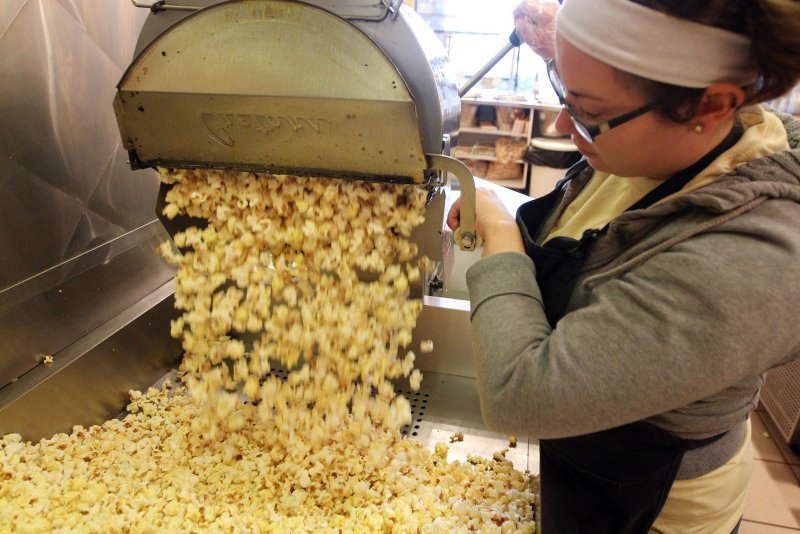Bridgett O'Brian makes a fresh batch of popcorn in 2014. Popcorn prices are predicted to increase, as supplies dwindle from farmers unable to plant this spring. File Photo by Bill Greenblatt/UPI |
License Photo
EVANSVILLE, Ind., June 20 (UPI) -- Going to a movie could become pricier later this year for people who enjoy popcorn with a flick. The snack will be in short supply because relentless spring rain prevented many growers across the Midwest from planting.
Popcorn processors estimate 30 to 40 percent of the nation's popcorn fields went unplanted this spring -- and the crops in many that were planted are growing poorly.
"It will be scarce," said Patrick Hopkins, an owner of Amish Country Popcorn, a family-owned popcorn distributor in Berne, Ind. "We actually just finished planting last week. We were very fortunate that we got it in. We've heard that a lot of popcorn growers were not able to get much planted."
What's more, most of the popcorn crop was planted too late to achieve normal fall yields. And many areas of the Midwest continue to experience record-breaking rainfall that is soaking newly planted fields, threatening to drown the young plants.
The reduced supply means that the price for popcorn will rise, said Brian Churchill, the Indiana plant manager for Preferred Popcorn.
"I'm guessing we'll see a 10 to 20 percent increase in price," Churchill said. "There will not be a shortage. Theaters will not run out of popcorn. But prices should be increasing, and eventually that will have to be passed on to the consumer."
It's too early to say for certain how much of an impact reduced planting will have on supplies or prices, Churchill said.
That is partly because the U.S. Department of Agriculture does not track popcorn production on a yearly basis. Therefore, the exact number of popcorn acres that could not be planted is unknown.
"We don't have any statistics on popcorn, other than it tends to follow corn," said Greg Matli, a state statistician with the USDA's National Agricultural Statistics Service's Indiana Field Office. "So, if they're behind in planting corn, they are behind in planting popcorn."
And corn planting is far behind.
As of Monday afternoon, farmers across the country had finished planting 92 percent of the acres they intend to plant in 2019, according to the USDA. In a normal year, planting finishes in early June.
But even this figure is misleading because farmers' intentions continually change, Matli said.
"So, you can have an area that has 80 percent of their intended acres planted," he said. "But, if everybody gives up and decides not to plant the rest of their acres, then next week it will show 100 percent planted, even though they've not planted anything."
The USDA will release data on the total number of corn acres planted this year in late June, Matli said. That report is likely to show a substantial number of acres were not planted.
The majority of the corn grown in the United States is known as "field corn," which often is a genetically modified corn variety with tough, bitter kernels used in animal feed and ethanol and processed into many food ingredients.
The majority of the roughly 90 million acres of corn grown each year in the United States is field corn. Only about 250,000 of those acres are devoted to popcorn -- mostly in Indiana and Nebraska. That's less than 3 percent.
"It's a very niche market," Churchill said.















